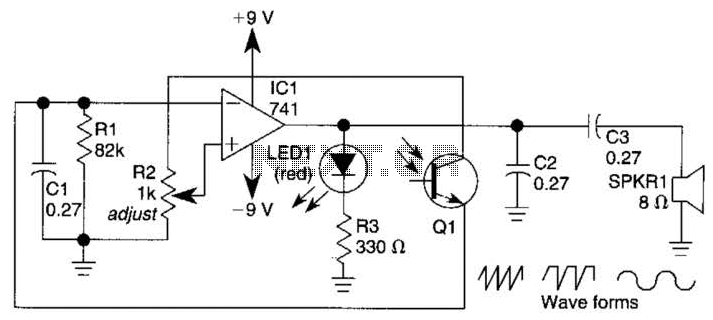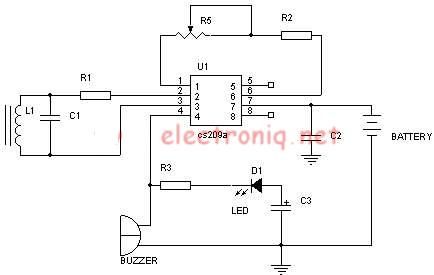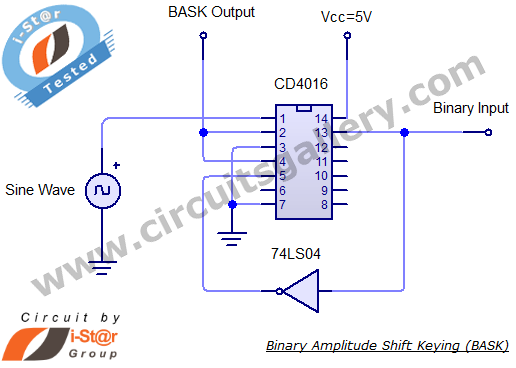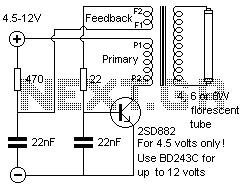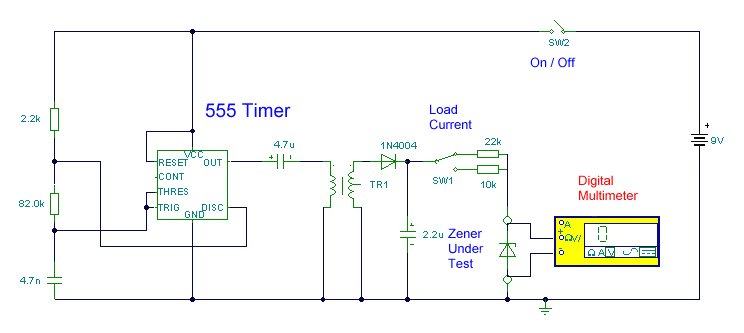
RF Module Interfacing Circuit Example
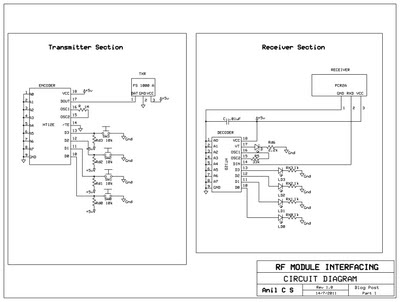
This document presents a circuit example for interfacing an RF module using the HT12E/D encoder-decoder pair. The attached circuit can be utilized for data transmission via the RF module, which is designed for single-channel operation, allowing only serial data transfers. The HT12E/D encoder-decoder pair is employed to convert parallel data into serial format and vice versa. The encoder-decoder pair supports 4-bit parallel data and consists of two sections: the transmitter and the receiver. In the transmitter section, the HT12E is used to encode data from parallel to serial format. The serial output from the encoder is connected to the data input of the RF transmitter. Four pushbutton switches, labeled SW0, SW1, SW2, and SW3, are utilized to input data into the decoder. These switches operate with active low states, meaning that when pressed, the data input registers as '0', and in the released state, it registers as '1', with the default state being '1'. In the receiver section, an RF receiver and the HT12D decoder IC are employed. The serial data received is fed into the serial input of the decoder, and the parallel data is indicated using LEDs. An additional LED connected to the VT pin of the decoder indicates the status of the link. If the LED is illuminated, the link is established; if it remains off, a link failure has occurred. The functionality of the VT pin can be further understood by referring to the IC's datasheet. After each successful transmission of 4-bit data, the VT pin goes low temporarily and returns to a high state, resulting in a blinking LED during transmission. If the circuit does not function as intended, it is recommended to disconnect the RF transmitter and receiver and establish a wired connection between the serial data output of the HT12E encoder and the serial data input of the HT12D decoder to troubleshoot the data transfer. If data is still not received, it may indicate an issue with the encoder/decoder pair, which could be due to circuit errors or damaged ICs.
The circuit utilizes the HT12E and HT12D integrated circuits to facilitate wireless communication through an RF module. The HT12E encoder converts parallel data inputs into a serial output that can be transmitted by the RF module. The data inputs are managed through four pushbutton switches, allowing users to manually input binary values. The RF transmitter then sends the encoded data wirelessly.
On the receiving end, the RF receiver captures the transmitted signal and feeds it into the HT12D decoder, which converts the serial data back into parallel form. The decoded output is displayed through LEDs, which provide a visual representation of the received data bits. The VT pin serves as a vital indicator of the communication link status. If the link is functioning correctly, the VT LED will blink to signify successful data transmission.
For troubleshooting, it is advisable to bypass the RF components and test the encoder and decoder directly through wired connections. This step will help isolate any issues with the RF transmission or the encoder-decoder functionality. Proper attention to the connections and the integrity of the ICs is crucial for ensuring reliable operation of the circuit.I am posting here a circuit example for interfacing RF module using HT12E/D encoder decoder pair. The circuit attached here can be used to transfer data using the RF module. As I have explained earlier RF module mentioned here is having a single channel. So we can use only serial data transfers. This example uses HT12E/D encoder-decoder pair for converting the parallel data to serial and back. This encoder-decoder pair supports 4 bit parallel data. Thecircuithas two parts transmitter and receiver. In the transmitter part we are using HT12E for encoding data from parallel to serial. The serial output from the from the encoder is fed to the data IN of the RF transmitter. Four switches namely SW0, SW1, SW2, SW3 are used to input data to the decoder. These switches are pushbutton switches with active low states. (i. e. when you press it, the data input will be `0` and in the released state data input will be `1`. The default state is `1`). At the receiver section we are having RF receiver and HT12D decoder IC. The serial data from the receiver is fed into to serial input of the decoder. The parallel data is displayed with the help of LED`s. AnotherLED at the pin VT of the decoder shows whether your link is established or not. If it is ON then everything is OK. Instead if it ispermanently OFF, then there is a linkfailure. You may refer the data sheet of the IC to know the exact function of pin VT. After eachsuccessfultransmission of a 4-bit data, VT pin goes to a low state for a while and will come back to high state. Thus during the transmission you may see the LED at pin VT blinking. If your circuit is not working, just remove the RF transmitter and receiver and make a wired connection from the serial data OUT of the HT12E encoder to the serial data IN of the HT12D decoder.
Now check whether you could receive the data send from the encoder to decoder. If it is not working, you can conclude that problem is with the encoder/decoder pair. Either there will be some bugs in the circuit or your IC`smightbedamagedones. 🔗 External reference
The circuit utilizes the HT12E and HT12D integrated circuits to facilitate wireless communication through an RF module. The HT12E encoder converts parallel data inputs into a serial output that can be transmitted by the RF module. The data inputs are managed through four pushbutton switches, allowing users to manually input binary values. The RF transmitter then sends the encoded data wirelessly.
On the receiving end, the RF receiver captures the transmitted signal and feeds it into the HT12D decoder, which converts the serial data back into parallel form. The decoded output is displayed through LEDs, which provide a visual representation of the received data bits. The VT pin serves as a vital indicator of the communication link status. If the link is functioning correctly, the VT LED will blink to signify successful data transmission.
For troubleshooting, it is advisable to bypass the RF components and test the encoder and decoder directly through wired connections. This step will help isolate any issues with the RF transmission or the encoder-decoder functionality. Proper attention to the connections and the integrity of the ICs is crucial for ensuring reliable operation of the circuit.I am posting here a circuit example for interfacing RF module using HT12E/D encoder decoder pair. The circuit attached here can be used to transfer data using the RF module. As I have explained earlier RF module mentioned here is having a single channel. So we can use only serial data transfers. This example uses HT12E/D encoder-decoder pair for converting the parallel data to serial and back. This encoder-decoder pair supports 4 bit parallel data. Thecircuithas two parts transmitter and receiver. In the transmitter part we are using HT12E for encoding data from parallel to serial. The serial output from the from the encoder is fed to the data IN of the RF transmitter. Four switches namely SW0, SW1, SW2, SW3 are used to input data to the decoder. These switches are pushbutton switches with active low states. (i. e. when you press it, the data input will be `0` and in the released state data input will be `1`. The default state is `1`). At the receiver section we are having RF receiver and HT12D decoder IC. The serial data from the receiver is fed into to serial input of the decoder. The parallel data is displayed with the help of LED`s. AnotherLED at the pin VT of the decoder shows whether your link is established or not. If it is ON then everything is OK. Instead if it ispermanently OFF, then there is a linkfailure. You may refer the data sheet of the IC to know the exact function of pin VT. After eachsuccessfultransmission of a 4-bit data, VT pin goes to a low state for a while and will come back to high state. Thus during the transmission you may see the LED at pin VT blinking. If your circuit is not working, just remove the RF transmitter and receiver and make a wired connection from the serial data OUT of the HT12E encoder to the serial data IN of the HT12D decoder.
Now check whether you could receive the data send from the encoder to decoder. If it is not working, you can conclude that problem is with the encoder/decoder pair. Either there will be some bugs in the circuit or your IC`smightbedamagedones. 🔗 External reference
